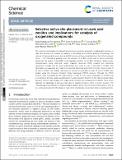Notice
This is not the latest version of this item. The latest version can be found at:https://dspace.mit.edu/handle/1721.1/135372.2
Selective active site placement in Lewis acid zeolites and implications for catalysis of oxygenated compounds
| dc.contributor.author | Rodríguez-Fernández, Aída | |
| dc.contributor.author | Di Iorio, John R | |
| dc.contributor.author | Paris, Cecilia | |
| dc.contributor.author | Boronat, Mercedes | |
| dc.contributor.author | Corma, Avelino | |
| dc.contributor.author | Román-Leshkov, Yuriy | |
| dc.contributor.author | Moliner, Manuel | |
| dc.date.accessioned | 2021-10-27T20:23:10Z | |
| dc.date.available | 2021-10-27T20:23:10Z | |
| dc.date.issued | 2020 | |
| dc.identifier.uri | https://hdl.handle.net/1721.1/135372 | |
| dc.description.abstract | © The Royal Society of Chemistry. The selective incorporation of isolated framework Lewis acid sites at specific crystallographic positions in high-silica zeolites was achieved by applying a rationalized post-synthetic grafting methodology. The removal of framework Ge atoms from a Ge-BEC zeolite with low concentrations of Ge in the framework (Si/Ge ∼ 150) followed by grafting allows the synthesis of Sn-BEC zeolites with Sn atoms positionally biased into the double-4-ring (D4R) crystallographic positions of the BEC framework. Spectroscopic characterization using solid-state nuclear magnetic resonance (NMR) coupled with theoretical calculations revealed that Sn atoms preferentially form open Sn sites in the D4R of Sn-BEC. This observation was supported by IR spectra of adsorbed deuterated acetonitrile (CD3CN), a known titrant of Sn sites in zeolites. The catalytic implications of selective incorporation of open Sn sites in Sn-BEC were probed using the Meerwein-Ponndorf-Verley-Oppenauer (MPVO) reaction. Although the MPVO turnover rates normalized by the total number of open Sn sites were comparable on Sn-BEC and a conventional Sn-Beta catalyst synthesized in fluoride media (Sn-Beta(F)), Sn-BEC demonstrated higher per gram reaction rates because of its larger fraction of open sites compared to Sn-Beta(F). These results highlight the advantage of placing active sites in targeted locations within a zeolite structure. The methodology presented here to selectively place catalytic active sites via sacrificial heteroatoms, such as Ge, can be generalized for the design of many other tetrahedrally-coordinated metal-containing zeolites. This journal is | |
| dc.language.iso | en | |
| dc.publisher | Royal Society of Chemistry (RSC) | |
| dc.relation.isversionof | 10.1039/D0SC03809A | |
| dc.rights | Creative Commons Attribution Noncommercial 3.0 unported license | |
| dc.rights.uri | https://creativecommons.org/licenses/by-nc/3.0/ | |
| dc.source | Royal Society of Chemistry (RSC) | |
| dc.title | Selective active site placement in Lewis acid zeolites and implications for catalysis of oxygenated compounds | |
| dc.type | Article | |
| dc.relation.journal | Chemical Science | |
| dc.eprint.version | Final published version | |
| dc.type.uri | http://purl.org/eprint/type/JournalArticle | |
| eprint.status | http://purl.org/eprint/status/PeerReviewed | |
| dc.date.updated | 2021-06-14T17:43:30Z | |
| dspace.orderedauthors | Rodríguez-Fernández, A; Di Iorio, JR; Paris, C; Boronat, M; Corma, A; Román-Leshkov, Y; Moliner, M | |
| dspace.date.submission | 2021-06-14T17:43:32Z | |
| mit.journal.volume | 11 | |
| mit.journal.issue | 37 | |
| mit.license | PUBLISHER_CC | |
| mit.metadata.status | Authority Work and Publication Information Needed |
